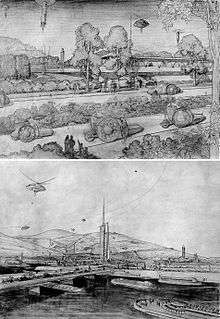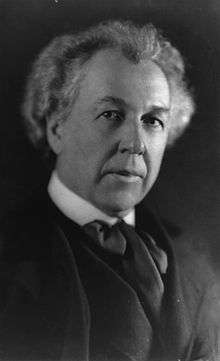Broadacre City
Broadacre City was an urban or suburban development concept proposed by Frank Lloyd Wright throughout most of his lifetime. He presented the idea in his book The Disappearing City in 1932. A few years later he unveiled a very detailed twelve by twelve foot (3.7 × 3.7 m) scale model representing a hypothetical four square mile (10 km²) community. The model was crafted by the student interns who worked for him at Taliesin, and financed by Edgar Kaufmann. It was initially displayed at an Industrial Arts Exposition in the Forum at the Rockefeller Center starting on April 15, 1935. After the New York exposition, Kaufmann arranged to have the model displayed in Pittsburgh at an exposition titled "New Homes for Old", sponsored by the Federal Housing Administration. The exposition opened on June 18 on the 11th floor of Kaufmann's store.[1] Wright went on to refine the concept in later books and in articles until his death in 1959.

Many of the building models in the concept were completely new designs by Wright, while others were refinements of older ones, some of which had rarely been seen.
Plan
Broadacre City was the antithesis of a city and the apotheosis of the newly born suburbia, shaped through Wright's particular vision.[2] It was both a planning statement and a socio-political scheme, inspired by Henry George, by which each U.S. family would be given a one acre (0.40 hectares) plot of land from the federal lands reserves, and a Wright-conceived community would be built anew from this.[3]. In a sense it was the exact opposite of transit-oriented development. There is a train station and a few office and apartment buildings in Broadacre City, but the apartment dwellers are expected to be a small minority. All important transport is done by automobile and the pedestrian can exist safely only within the confines of the one acre (0.40 hectares) plots where most of the population dwells.
In his book Urban Planning Theory since 1945, Nigel Taylor considers the planning methodology of this type of city to be Blueprint planning, which came under heavy criticism in the late 1950s by many critics such as Jane Jacobs, in her book The Death and Life of Great American Cities.
Similar models
Some of the earlier garden city ideas of the landscape architect Frederick Law Olmsted and the urban planner Ebenezer Howard had much in common with Broadacre City, save for the absence of the automobile, born much later. More recently, the development of the edge city is like an unplanned, incomplete version of Broadacre city.
The R. W. Lindholm Service Station in Cloquet, Minnesota, shows some of Wright's ideas for Broadacre City.
See also
References
- Hoffmann, Donald (1993). Frank Lloyd Wright's Fallingwater: The House and Its History (2nd Revised ed.). New York: Dover Publications. pp. 11–25. ISBN 9780486274300.
- Nelson, A. (1995). "The planning of exurban America: Lessons from Frank Lloyd Wright's Broadacre City". Journal of Architectural and Planning Research. 12 (4): 339.
- The Disappearing City, in Frank Lloyd Wright. Frank Lloyd Wright Collected Writings, volume 3: 1931-39. Edited by Bruce Brooks Pfeiffer, introduction by Kenneth Frampton (Rizzoli International Publications, Inc., New York City, 1993), 91: "In the City of Tomorrow ground space will be reckoned by the acre: an acre to the family."
Further reading
- Krohe, James Jr. Return to Broadacre City. Illinois Issues April 2000, 27. Also in digital form on the Web.
- Pimlott, Mark. "Frank Lloyd Wright & Broadacre City". In M. Pimlott's Without and within: Essays on territory and the interior, Rotterdam, Episode Publishers, 2007
- Wright, Frank Lloyd (1932). The Disappearing City. New York: W.F. Payson. ASIN B0000EF481.
- Wright, Frank Lloyd (1945). When Democracy Builds. University of Chicago press. ASIN B0007DS1NS.
- Wright, Frank Lloyd (1958). The Living City. Horizon Press. ISBN 9780818000058.
- Illustrations
- Photograph of Broadacre City model
- Plan of Broadacre City model
